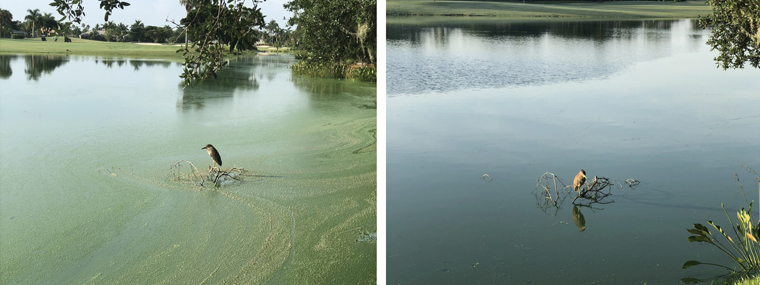
What We Can Learn from the Worst Algae Catastrophes in History
By Greg Blackham, Aquatic Specialist / Published April 2020

Cyanobacteria, often referred to as blue-green algae, are changing the way providers of green consulting services approach algae management in lakes and ponds. Harmful algal bloom (HAB) treatments reached an all-time high in 2018. HABs have the potential to be highly toxic and can severely impact the health and well-being of all nearby humans, pets, and wildlife. The devastating effects of harmful algal blooms have been witnessed repeatedly throughout the U.S. over the past 10 years. There is no area of the country that is safe from the threat of HABs as two recent catastrophes from very different parts of the country show us. We can, however, learn from these natural ecological disasters and implement proactive lake management strategies to help avoid them in the future.
Toxic algal blooms have plagued Florida’s largest freshwater lake, Lake Okeechobee, over the past several years. Cyanobacteria cover almost the entire lake each summer and transform the beautiful aquatic ecosystem to a thick, green, pea-soup color. Most of the HABs found in the lake produce toxins that are very dangerous to humans, fish, and other wildlife. Cyanotoxins also are capable of becoming airborne, meaning contact with the water is not the only means of exposure. The polluted waters of Lake Okeechobee are not just contained to the lake; they pollute everything downstream, including the St. Lucie River and Caloosahatchee River. Eventually, these systems dump the toxic algae along Florida’s east and west shorelines, polluting these once beautiful tourist destinations with a thick brown sludge that severely limits access to swimming and fishing.
Massive harmful algal blooms don’t just occur in warm regions of the South. Many people are familiar with Lake Erie and remember the media attention around the massive blue-green algae outbreaks of 2011 and 2015. Yearly blooms of cyanobacteria on Lake Erie not only threaten local wildlife and people who come into direct contact with the water while utilizing the lake but also threaten all of the towns and cities, such as Toledo, Ohio, that use the lake as a source of drinking water.
Much scarier than the acute effects of cyanotoxins is a growing connection between blue-green algae and neurodegenerative diseases such as ALS, Alzheimer’s disease, and Parkinson’s disease. Studies have found a direct link between these diseases and beta-Methylamino-L-alanine (BMAA), a nerve toxin produced by cyanobacteria. The blue-green algae capable of making BMAA are ubiquitous and can be found in almost any waterbody, even those as small as a stormwater pond or ditch.
What is causing this explosion of recent toxic algae growth? Many factors contribute to algae growth, including temperature, sunlight, and carbon dioxide, but nutrients are the main differentiator between a balanced waterbody and a disaster. Nutrient pollution caused by urban growth, industrial development, and agricult-ural waste is making its way to our water resources.
Fertilizers and pollutants from residential lawns and commercial turfgrass flow to our lakes, ponds, waterways and, eventually, bays and oceans. Concentrated stormwater runoff is now diverted and funneled into waterbodies that were never meant to process so many nutrients. Wetlands, which once served as natural nutrient “filters,” have been displaced by roads, sidewalks, and other impervious surfaces. The result is unhealthy and unbalanced aquatic ecosystems.
Proper identification of HABs is crucial and can be confirmed through water quality tests carefully assessed by a professional lake manager. Water quality testing can reveal the species causing the bloom and confirm whether or not toxins are present. SOLitude utilizes in-house, state-of-the-art laboratory analysis to reveal potential water quality imbalances that can encourage HABs to develop. Once identified, steps can be taken to proactively minimize the issue and prevent future algal outbreaks.
Proactive management strategies have proven very effective at limiting the negative effects of nutrient loading. A large percentage of nutrient pollution stems from poor cultural habits. As individuals, we can do our part by cleaning up pet waste, reducing fertilizer use (or switching to phosphorous-free products), improving our recycling habits, and properly disposing of grass clippings and leaves.
Proactive lake management strategies should also be implemented. Creating a living shoreline of beneficial native plants around lakes and ponds further protects them from erosion and runoff. Also, the installation of submersed aeration systems or floating fountains helps provide an oxygen-rich aquatic environment, which leads to improved water quality.
Waterbodies that have suffered from unbalanced water quality for many years may require more impactful restoration tools. Ecologically friendly products like Phoslock and Biochar can be applied to the water column to “de-activate” undesirable nutrients, thus preventing them from ever fueling the growth of aquatic weeds or algae. Physically removing nutrient-rich muck and sludge from lake bottoms using a mechanical hydro-rake can help provide the same benefits, while “turning back time” on the aquatic resource to facilitate increased water volume and depth. Integrating new technologies is also key to eradicating and preventing cyanobacteria. For example, nanobubble aeration is a new and innovative solution that is capable of quickly reducing the impacts of nutrients responsible for fueling aquatic weeds and algae.
As an aquatic management professional who has managed lakes and ponds for nearly 15 years, I can assure you that a proactive approach combining preventive cultural practices and restorative measures in polluted waters is the most effective and least costly approach. Reducing the frequency at which severe harmful algal blooms occur is certainly achievable. We need not wait for the next algae catastrophe to strike; let’s stop it first.
Greg Blackham
Aquatic Specialist, SOLitude Lake Management
Greg Blackham is an Aquatic Specialist with SOLitude Lake Management, an environmental firm that specializes in sustainable lake, stormwater pond, wetland, and fisheries management services. Learn more about this topic at www.solitudelakemanagement.com/knowledge.









